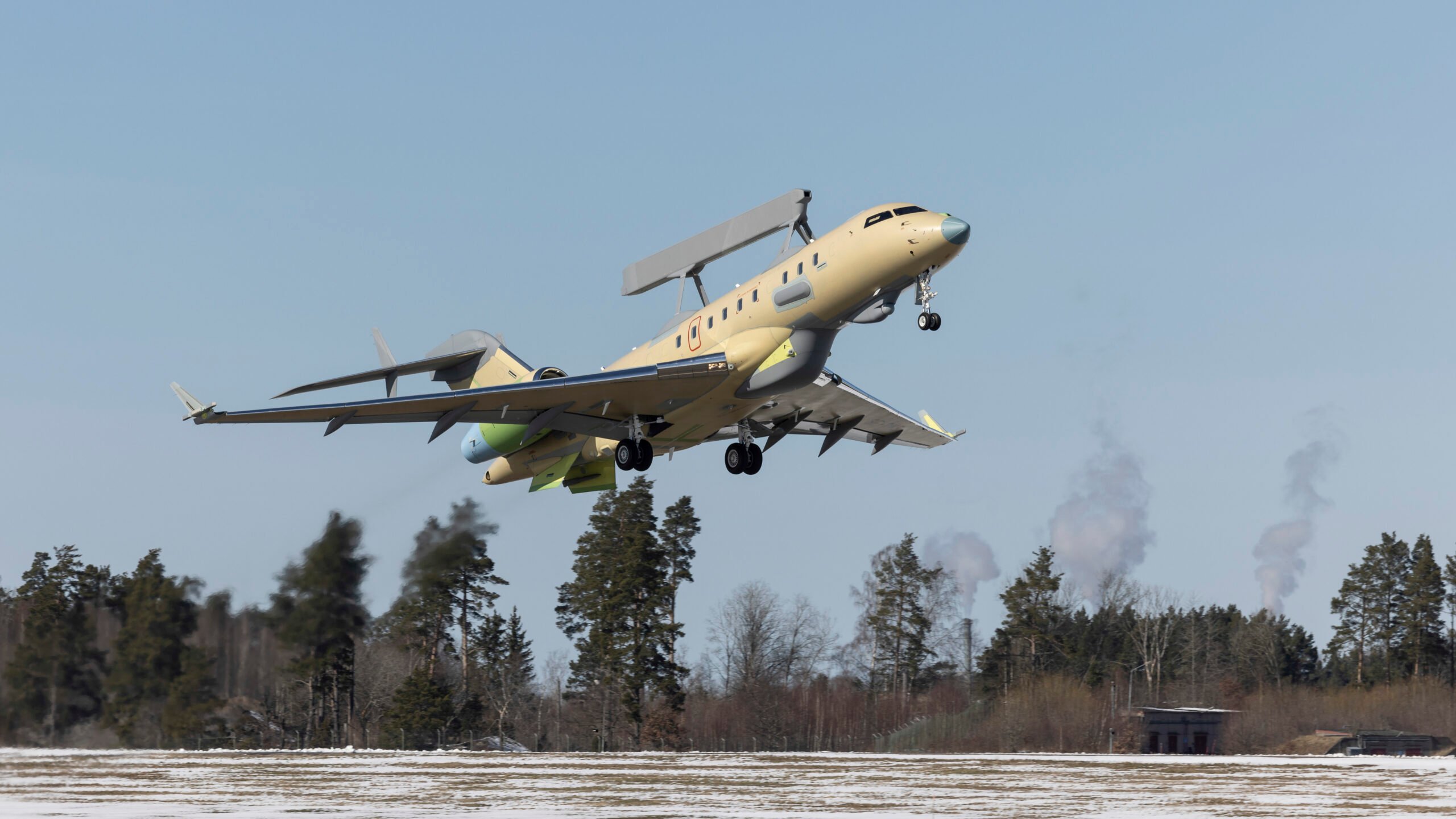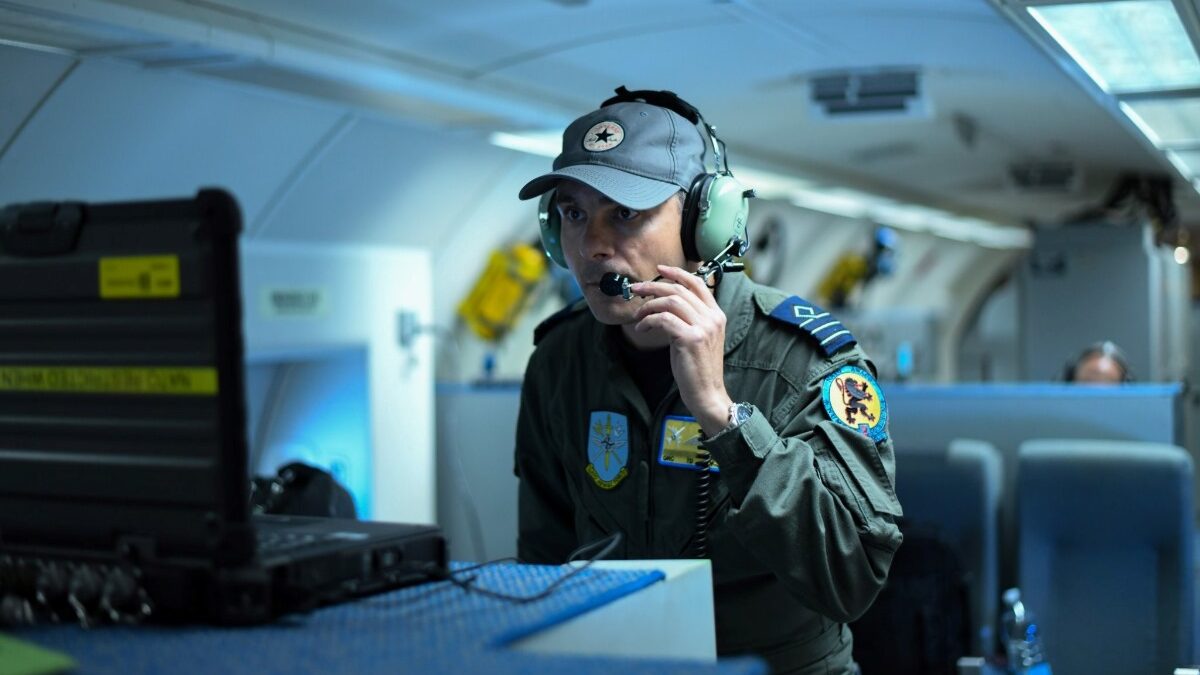
The UAE’s fourth GlobalEye Airborne Early Warning and Control (AEW&C) aircraft undergoes flight testing at Saab’s airfield in Linköping, Sweden (Saab)
BELFAST — Swedish manufacturer Saab has strongly hinted at a wave of future military sales once Sweden enters NATO and on the basis that increased defense spending across Europe will continue long term as a response to Russian intimidation.
Despite such a positive business outlook, however, security of supply issues are of upmost concern beyond the “foreseeable future,” according to Saab CEO and President Micael Johansson.
“Fortunately we have secured quite a lot of material, explosives, powder and semiconductors for the foreseeable future, but to take the next step of doubling capacity that we’re doing now, we need more investments in the ecosystem,” he said during Saab’s Q1 2023 financial results media call today. “Everyone [from industry] needs explosives and powder to make 155 millimeter ammunition and we need it for 84 millimeter ammunition, so some countries may have to come together to invest in this going forward, to [create] a higher level of resilience and security of supply.”
Johansson’s comments echo those from other leading European industry leaders, including Eric Beranger, CEO at missile maker MBDA, who said in March that there have been occasions when some components had “suddenly” become unavailable for 24 months at a time. Beranger also went on to explain that the surge in weapons demand across Europe caused by the Ukraine conflict had led to “tension on the supply chain.” The comments were much less optimistic than those of leaders at US-based Raytheon, who said Tuesday that the supply chain was getting “a hell of a lot better” even if there were bottlenecks of concern.
Beyond supplier challenges, Saab stands to gain considerably from Sweden’s entry to NATO. An early example is a signed framework agreements worth SEK 350 million ($33.8 million) with the NATO Support and Procurement Agency (NSPA) for Carl Gustaf M4 recoilless rifles and AT-4 anti-armor weapons in March.
“I see this [period] as just the beginning of defense spending increases in Europe,” said Johansson. “I see great possibilities when we eventually join NATO as a country. We have already started to see potential contracts coming in… and we continue to work on other common acquisitions from the NATO perspective.”
He added that even though Sweden is currently “inside the fence” as a NATO invitee, it is more important to move to a full NATO member.
Membership has been complicated politically by Turkey, which along with Hungary has delayed the Nordic nation’s joining. NATO Secretary General Jens Stoltenberg has however insisted that the ascension process will be completed before the alliance’s Heads of State Summit in Vilnius, Lithuania, in July.
Meanwhile, Johansson said that during Q1 2023 Saab had proposed the company’s GlobalEye Airborne Early Warning and Control (AEW&C) aircraft when responding to NATO’s Allied Future Surveillance and Control (AFSC) capability program Request for Information (RFI). GlobalEye faces competition from Boeing’s E-7 Wedgetail if it is to eventually secure a AFSC order.
“We have provided information about GlobalEye, in terms of it being in production, short lead times, it being cost efficient and it being a fantastic capability,” he explained. Johansson also said that Saab could offer NATO “full operations” with GlobalEye sooner than the alliance’s initial operating capability (IOC) timeline for the new AEW&C program.
NATO currently operates a fleet of 14 E-3A AEW&C aircraft based in Geilenkirchen, Germany.

A NATO E-3A crew member on board during exercise Real Thaw (NATO)
GlobalEye, based on Bombardier’s Global 6000 business jet, has been ordered by Sweden and the UAE. Test flights of a fourth aircraft for Abu Dhabi from Saab’s airfield in Linköping, Sweden, commenced earlier this month.
Financially, a strong order book for Q1 2023 saw Saab sales reach SEK 11.5 billion ($1.1 billion), an increase of 25 percent over Q1 2022. The most lucrative contract supporting those sales was a SEK 8.5 billion ($825 million) order from an undisclosed western country for equipment, including Carl-Gustaf rifles and RBS 70 NG man-portable air-defense system (MANPADS). Johansson said that sensitivities prevented him from sharing the identity of the customer.
Other sales highlights over the quarter included a SEK 308 million ($29.9 million) Gripen C/D fighter jet support and maintenance contract with the Swedish Defence Materiel Administration (FMV) and a SEK 400 million ($38.8 million) NLAW (Next Generation Light Anti-Tank Weapon) order from the Finnish Defence Forces Logistics Command.
Problems persist, however, with the US Air Force’s T-7 advanced jet trainer program. As Breaking Defense reported last week serial production of the aircraft won’t happen until 2025, on account of a two-year delay caused by design issues discovered during prototype aircraft manufacturing. Johansson said that profitability on the program will suffer until low rate initial production starts.
Saab also continues to pursue new Gripen E/F sales, which include potential “extensions” to previous business with Hungary and the Czech Republic and the possibility of a deal with the Philippines for C/D variants, according to Johansson. That extension with the Czech Republic, operating Gripen jets under lease, looks decidedly difficult after Prague selected Lockheed Martin’s F-35 fighter jet to replace the Swedish aircraft.
Northrop sees F-16 IVEWS, IBCS as ‘multibillion dollar’ international sales drivers
In addition, CEO Kathy Warden says the company sees a chance to sell up to five Triton UAVs to the NATO alliance.


























